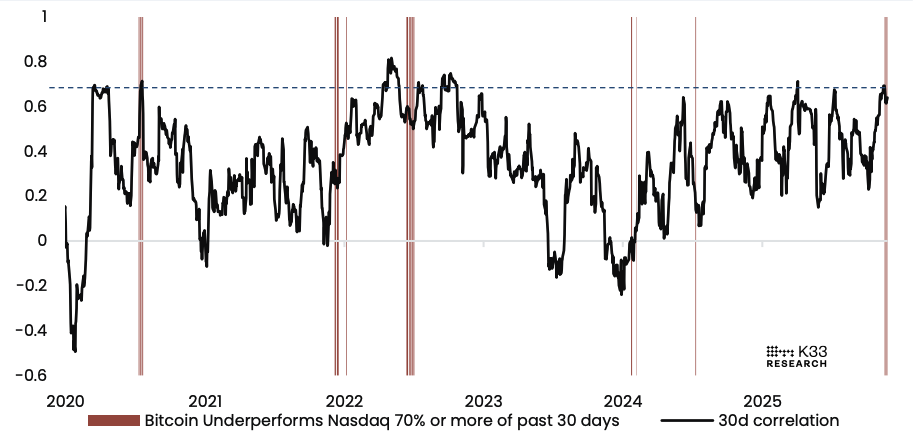Bitcoin Market Analysis: A Deeper Dive into Recent Trends
Bitcoin has recently experienced a significant downturn of 36% from its all-time highs, a phenomenon described by research and brokerage firm K33 as a sentiment-driven overshoot. This market correction presents what K33 interprets as an attractive long-term entry point for investors. According to K33’s Head of Research, Vetle Lunde, Bitcoin has underperformed compared to the Nasdaq in 70% of sessions over the past month—a rare occurrence that can have profound implications for investors.
Relative Performance and Market Dynamics
Since October 8, Bitcoin’s relative strength compared to the Nasdaq has declined by 30%. This period of underperformance draws parallels to previous notable downturns triggered by distinct shocks in the cryptocurrency domain. Key events like the Mt. Gox disaster and substantial Grayscale outflows have contributed to similar patterns of relative underperformance in the past. As observed by Lunde, such downturns are often accompanied by decreased correlations between Bitcoin and equities, highlighting a disconnection caused by macroeconomic factors and market sentiment.
Price Correlation Trends
Following the deleveraging event on October 10, Bitcoin’s price relative to the Nasdaq’s QQQ index hit its lowest point since November 2024. Lunde notes that this decline results in Bitcoin retracing all relative strength gains made after the U.S. elections. Interestingly, while correlations with equities have increased, Bitcoin has exhibited steeper declines during market downturns and less robust recoveries during upswings, indicating a concerning trend of persistent selling pressure in a risk-averse market environment.
Market Structure Shifts
Lunde emphasizes that today’s Bitcoin market structure differs significantly from previous cycles. Recent legislative moves, such as crypto initiatives from Tier-1 banks and the Clarity Act, signal a shift that may soon broaden accessibility to cryptocurrencies. He asserts that the current pricing of Bitcoin relative to other risk assets presents a noteworthy disconnect from its underlying fundamentals, positioning Bitcoin as a compelling long-term investment.
Panic Signals and Trading Activity
Recent trading activity signals a nearing saturation point in the sell-off, underlined by substantial spot trading volumes. On November 21, Bitcoin dropped to an intraday low of $80,500, generating spot volumes of $14.3 billion—the sixth-highest for 2025. Prior instances of daily spot volumes exceeding $10 billion have typically occurred around local highs or lows, but this trend has re-emerged several times during the downturn, reflecting an intense buy-side interest near new support levels.
Derivatives Market Insights
Further analysis of the derivatives market reveals a notable increase in open interest for perpetual futures, peaking at 325,000 BTC during the sell-off. Although there has been a recent decline, this is viewed as an improvement over a previous state of overheated leverage. Lunde observes that ETP flows are also indicative of market stress, with significant daily outflows not only being rare but concerning, especially given that two of the four occurrences this year have happened within the month.
Conclusion: Cautious Optimism in a Volatile Landscape
In summary, the current market environment for Bitcoin reflects elevated panic, common in phases where market sentiment overshoots fundamentals. K33 had previously reduced risk exposure when Bitcoin was priced at $95,000, but has cautiously re-engaged at $83,200, as market panic intensified. However, they remain hesitant to fully commit until market indicators stabilize. As such, while there are significant opportunities for long-term investors, careful navigation through this volatile landscape remains crucial as Bitcoin continues to react to broader economic trends.
In a rapidly evolving cryptocurrency market, staying informed about emerging trends, trading behavior, and market sentiment is essential for any investor aiming to minimize risk and capitalize on potential opportunities.


